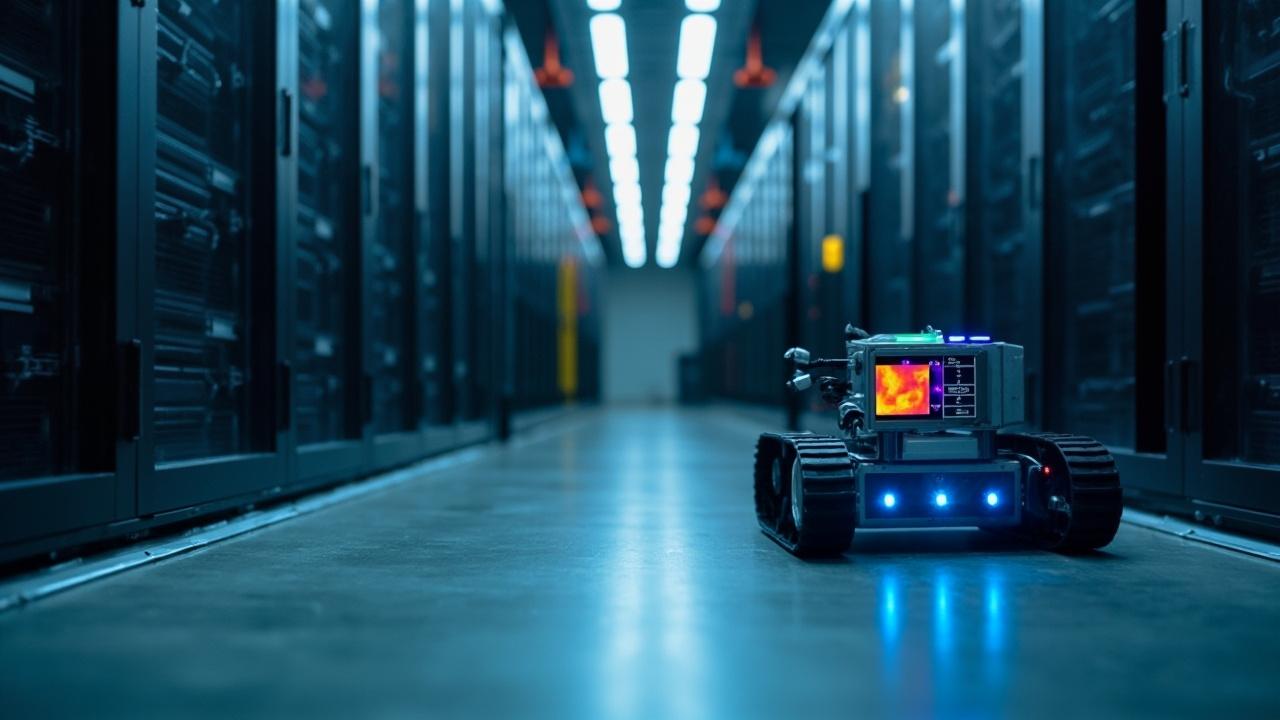Introduction
The relentless growth of the digital world is fueling an unprecedented expansion of data centers. Projections estimate the global data center market will reach staggering heights by 2024, a surge demanding smarter and more efficient maintenance solutions.
Traditional data center maintenance, heavily reliant on manual labor, is struggling to keep pace, often hampered by high costs, the potential for human error, and inherent safety risks. The need for a paradigm shift is evident, and the answer may lie in robotic maintenance.
For years, data centers have depended on technicians to perform routine tasks, react to failures, and generally ensure optimal performance. These tasks often involve working in challenging environments, navigating complex cabling, and handling sensitive equipment. The limitations of this approach are becoming increasingly apparent as data centers grow in size and complexity.
Human error can lead to costly mistakes, and the reactive nature of traditional maintenance often results in unplanned downtime. The escalating costs associated with skilled labor further compound these challenges, making it imperative to explore innovative alternatives.
Enter robotic maintenance, a transformative approach poised to reshape the data center landscape. By automating routine inspections, repairs, and maintenance tasks, robots offer the potential to significantly enhance efficiency, improve safety, and enable predictive capabilities. This shift not only promises to reduce downtime and operational expenses but also allows human technicians to focus on more complex and strategic initiatives, ultimately ushering in a new era of data center management.
Why Data Centers Need Robotic Solutions
The ever-increasing demands placed on modern data centers are creating a perfect storm of challenges that traditional maintenance methods simply can’t address effectively. The density of computing equipment is skyrocketing, leading to increased heat generation and placing immense strain on cooling systems. Efficient cooling is not just a matter of performance; it’s crucial for preventing equipment failure and costly downtime. Furthermore, the human element presents its own set of limitations and risks.
The Rising Cost of Skilled Labor
Finding and retaining qualified technicians is becoming increasingly difficult and expensive. The specialized skills required to maintain complex data center infrastructure are in high demand, driving up labor costs and creating a shortage of skilled personnel. This is further compounded by the inherent risks associated with human workers performing tasks in potentially hazardous environments.
Electrical hazards, confined spaces, and the need to work around sensitive equipment all contribute to a higher risk of accidents and injuries. This is where robotic maintenance offers a tangible solution. By automating routine and hazardous tasks, data centers can reduce their reliance on human labor, minimize the risk of accidents, and ensure consistent, reliable maintenance.
Benefits of Robotic Maintenance
The benefits of implementing robotic solutions extend beyond simply replacing human labor. By enabling continuous monitoring and proactive maintenance, robotic maintenance can significantly reduce downtime, improve cooling efficiency, and lower energy costs. Robots equipped with advanced sensors can detect anomalies and potential problems before they escalate into critical failures, allowing for timely intervention and preventing costly outages.
For example, thermal imaging robots can identify hotspots within server racks, allowing technicians to address cooling issues before they lead to equipment damage. This proactive approach not only minimizes downtime but also extends the lifespan of critical infrastructure. With the increasing complexity and demands of data centers, robotic maintenance is rapidly transitioning from a futuristic concept to a necessity for ensuring operational efficiency and resilience.
Spotlight on Key Robotic Maintenance Tasks
Robots are quickly becoming invaluable assets in modern data centers, tackling a variety of tasks with precision and efficiency. These automated systems are designed to handle repetitive, dangerous, or highly precise operations, freeing up human technicians to focus on more complex problem-solving and strategic initiatives. Let’s take a closer look at some of the specific maintenance tasks robots are now performing, revolutionizing data center management.
Temperature and Humidity Checks
Maintaining optimal environmental conditions is critical for the reliable operation of data center equipment. Overheating or excessive humidity can lead to equipment failure and costly downtime. Robots equipped with advanced sensors are deployed to continuously monitor temperature and humidity levels throughout the data center.
These robots can traverse the entire facility, collecting data at various points and generating detailed heatmaps. Any anomalies or deviations from the acceptable range are immediately flagged, allowing technicians to address potential issues before they escalate. This proactive approach to environmental monitoring significantly reduces the risk of equipment failure and ensures optimal performance.
Leak Detection
Water leaks, whether from cooling systems or external sources, pose a significant threat to data center infrastructure. Even small leaks can cause extensive damage to sensitive electronic equipment. Robots equipped with specialized sensors can detect the presence of water or other fluids in critical areas, such as under floors and around cooling units.
These robots can be programmed to follow specific routes, scanning for leaks and generating alerts when anomalies are detected. The ability to quickly identify and address leaks minimizes the potential for water damage and prevents costly downtime. This also ensures any potential hazards are dealt with effectively and quickly by trained professionals.
Cable Management
Data centers often contain a complex web of cables, making it challenging to maintain organization and troubleshoot issues. Tangled or improperly routed cables can impede airflow, increase the risk of overheating, and make it difficult to identify and resolve connectivity problems.
Cable management robots are designed to navigate this intricate infrastructure, identifying and organizing cables, correcting routing issues, and detecting potential faults. These robots can use visual recognition technology to identify cable types and connections, ensuring that everything is properly connected and labeled.
By automating cable management, data centers can improve airflow, reduce the risk of connectivity problems, and streamline troubleshooting efforts. The result is a more efficient, reliable, and manageable data center environment, and a welcome improvement over manual maintenance methods. The incorporation of robotic maintenance can significantly impact the efficiency of daily operations.
The Rise of Robotic Maintenance in Data Centers
Data centers around the globe are beginning to embrace robotic solutions to address a myriad of challenges, from increasing efficiency to reducing operational costs. These implementations are no longer just theoretical; they are tangible and producing quantifiable results.
By examining real-world examples, we can see the significant impact that robotic maintenance is having on the data center landscape. This section will spotlight a few specific cases where robotic maintenance has been successfully deployed, showcasing the benefits and practical applications of this innovative approach.

One compelling example is a large-scale colocation facility in Northern Virginia that integrated autonomous inspection robots to monitor its cooling infrastructure. Prior to the deployment of robots, technicians had to manually inspect cooling units, a time-consuming and potentially error-prone process. The robots, equipped with thermal imaging cameras and environmental sensors, now continuously patrol the data center floor, identifying hotspots, leaks, and other anomalies.
This proactive approach has led to a 15% reduction in energy consumption related to cooling and a significant decrease in the risk of equipment failure due to overheating. Furthermore, the data collected by the robots has enabled the facility to optimize its cooling strategies, resulting in further energy savings and improved overall efficiency. The reduced risk of downtime events has improved the SLA (Service Level Agreement) results with their clients, and provided a higher degree of business assurance.
Another notable case involves a hyperscale data center in Oregon that utilizes cable management robots to maintain its vast and complex network infrastructure. With millions of cables running throughout the facility, keeping everything organized and identifying faulty connections was a monumental task. The cable management robots, equipped with advanced imaging and manipulation capabilities, are able to autonomously navigate the cable trays, identify mislabeled or damaged cables, and even assist with the installation of new cables.
Since implementing these robots, the data center has seen a 40% reduction in cable-related downtime incidents and a significant improvement in network performance. Moreover, the robots have freed up technicians to focus on more complex tasks, such as network design and optimization, further enhancing the overall efficiency of the data center.
| Metric | Improvement |
|---|---|
| Cooling Energy Consumption (Colocation Facility) | 15% Reduction |
| Cable-Related Downtime (Hyperscale Data Center) | 40% Reduction |
Types of Robots Revolutionizing Data Center Operations
Data centers, the backbone of the digital age, are increasingly relying on automation to maintain optimal performance and efficiency. Among the most promising advancements is the deployment of specialized robots designed to tackle specific maintenance challenges. These robots are not simply futuristic novelties; they are practical solutions addressing critical needs within the demanding data center environment. From safeguarding against overheating to ensuring robust cable infrastructure, various types of robots are actively transforming how data centers operate.
One category of these robotic solutions are autonomous inspection robots. These robots are essentially mobile sensor platforms, equipped with a suite of tools like thermal cameras, humidity sensors, and airflow monitors. They navigate the data center floor, collecting data on environmental conditions and potential hazards.
Some models, like the Boston Dynamics Spot, can even be customized with additional sensors for specific tasks, such as detecting unusual vibrations or identifying potential water leaks. By continuously monitoring the data center, these robots provide early warnings of potential problems, allowing for proactive intervention and preventing costly downtime.
Another crucial application of robots is in cable management. Data centers often house a complex web of cables that can be difficult to manage and maintain. Cable management robots are designed to navigate this tangled infrastructure, identifying and organizing cables, tracing connections, and detecting faults.
These robots often use visual recognition and mapping technologies to understand the cable layout and automatically correct any faults. With these robots, technicians can ensure that cables are properly connected, labelled, and routed, minimizing the risk of errors and reducing the time required for maintenance.
| Robot Type | Function | Benefits |
|---|---|---|
| Autonomous Inspection Robots | Monitor temperature, humidity, airflow, and potential hazards | Early warning of potential problems, reduced downtime, proactive intervention |
| Cable Management Robots | Organize cables, trace connections, and detect faults | Minimized risk of errors, reduced maintenance time, improved cable organization |
| Cleaning and Dusting Robots | Automate cleaning tasks, remove dust and debris | Improved airflow, reduced risk of equipment failure, enhanced energy efficiency |
Benefits of Robotic Maintenance
Robots bring a level of efficiency to data center operations that traditional methods simply cannot match. They operate tirelessly, 24/7, without breaks or errors caused by fatigue. This continuous operation translates to faster completion of maintenance tasks, optimized resource utilization, and the ability to handle a larger volume of work with fewer resources.
For example, tasks like server rack inspections, which might take a human technician hours, can be completed by a robot in a fraction of the time. This increased speed not only reduces labor costs but also minimizes the impact of maintenance activities on data center performance.
Data centers are inherently hazardous environments, with potential risks ranging from electrical shocks to exposure to extreme temperatures. Robots can perform tasks in these dangerous settings, eliminating the need for human workers to put themselves in harm’s way. This is particularly beneficial for tasks such as working near high-voltage equipment, inspecting cooling systems in confined spaces, or handling heavy components.
By offloading these hazardous duties to robots, data centers can significantly reduce the risk of accidents and injuries, creating a safer working environment for their human staff. The implementation of robotic maintenance ensures not only efficiency but worker safety as well.
One of the most significant benefits of robotic maintenance is its ability to proactively identify and address potential issues before they lead to downtime. Equipped with advanced sensors and analytics capabilities, robots can continuously monitor critical infrastructure, detect anomalies, and predict potential failures. This proactive approach allows data center operators to schedule maintenance activities in advance, preventing unexpected outages and minimizing disruptions to services.
For instance, a robot might detect a gradual increase in temperature in a particular server rack, indicating a potential cooling problem. By alerting technicians to this issue early on, they can take corrective action before the server overheats and causes a system failure.
Implementing Robotic Maintenance
Embarking on the journey of integrating robotic systems into your data center requires careful thought and strategic planning. It’s not simply about deploying robots; it’s about creating a symbiotic relationship between humans and machines to optimize your operations. A successful implementation hinges on understanding your data center’s unique needs, selecting the right robotic solutions, and establishing a robust framework for operation and maintenance.
Before taking the plunge, conduct a thorough assessment of your data center’s pain points and areas where automation can yield the most significant benefits. Consider factors such as the age of your infrastructure, the complexity of your layout, the skill level of your existing staff, and the frequency of maintenance tasks.

This analysis will help you prioritize your robotic investments and tailor your implementation plan accordingly. Once you have identified the area you wish to focus on, consider the following questions:
Selecting the right robots is crucial for a successful implementation. There’s no one-size-fits-all solution, as different robots are designed for specific tasks and environments. Consider factors such as payload capacity, range of motion, sensor capabilities, and software integration.
Evaluate vendors carefully and choose robots that are reliable, scalable, and easy to maintain. Remember that cost should not be the sole determining factor. A slightly more expensive robot with superior performance and support can often provide a better return on investment in the long run.
A comprehensive implementation plan is essential for smooth integration and long-term success. This plan should include detailed procedures for robot deployment, training, safety protocols, and ongoing maintenance. It’s important to involve your existing staff in the implementation process to ensure buy-in and minimize disruption.
Develop clear communication channels and provide adequate training to enable your team to work effectively with the robots. Furthermore, establish a schedule for regular maintenance and inspections to keep your robots in optimal condition. The ability to seamlessly integrate robotic maintenance into your existing data center management platforms allows for a smooth operation and data analysis.
The Future of Robotic Maintenance in Data Centers
The data center landscape is on the cusp of a significant transformation, driven by advancements in robotic technology. Imagine a future where routine maintenance, complex repairs, and proactive monitoring are all handled seamlessly by intelligent machines. Emerging trends point towards an increased reliance on AI-powered robots capable of learning and adapting to dynamic data center environments.
We can anticipate the development of sophisticated swarm robotics, where teams of robots collaborate to address intricate challenges, such as optimizing airflow and identifying hotspots with unparalleled precision. This collaborative approach could revolutionize how we manage and maintain these critical infrastructures.
Furthermore, the potential for robots to perform increasingly complex tasks is immense. Predictive maintenance, for example, is poised to become a reality. Equipped with advanced sensors and machine learning algorithms, robots can analyze vast amounts of data to anticipate equipment failures before they occur.
This proactive approach minimizes downtime and prevents costly disruptions. Even self-healing infrastructure, where robots autonomously repair minor damages or replace failing components, is no longer a far-fetched concept. The evolution of robotic maintenance will allow companies to spend less time and money on the day to day upkeep of their data centers.
The long-term benefits of embracing robotic maintenance solutions are clear: increased efficiency, reduced costs, and improved reliability. As data centers grow in scale and complexity, the need for automated solutions becomes ever more critical.
By investing in robotic technology, organizations can ensure their data centers remain competitive, resilient, and capable of meeting the ever-increasing demands of the digital age. The convergence of AI, robotics, and data analytics will unlock unprecedented levels of automation and optimization within the data center environment.
Consider the following potential advancements:
Conclusion
In conclusion, the integration of robotic solutions into data center maintenance is no longer a futuristic concept, but a tangible and rapidly evolving reality. The advantages are undeniable: improved efficiency in performing repetitive tasks, enhanced safety for personnel by mitigating hazardous work, and significantly reduced downtime through proactive monitoring and rapid response. Data centers that recognize and embrace this paradigm shift are poised to gain a significant competitive edge in an increasingly demanding market.
The move toward robotic maintenance isn’t just about replacing human labor with machines; it’s about creating a more intelligent, resilient, and cost-effective infrastructure. By leveraging the capabilities of autonomous inspection robots, cable management robots, cleaning robots, and robotic arm systems, data centers can unlock unprecedented levels of operational efficiency and reliability. Furthermore, the scalability of robotic solutions ensures that data centers can adapt to future growth and evolving technological landscapes without facing insurmountable challenges.
The time to explore the potential of robotic maintenance is now. Staying ahead in the data center industry demands innovation and a willingness to adopt cutting-edge technologies. Contact us today to discover how incorporating robotic solutions into your data center strategy can revolutionize your operations, drive down costs, and secure your IT infrastructure for the future.
Frequently Asked Questions
What are the primary benefits of using robots for maintenance tasks?
The use of robots for maintenance tasks offers numerous benefits. Robots can perform repetitive, dangerous, or physically demanding tasks with greater efficiency and consistency than humans. They reduce downtime through continuous operation and faster inspection times, leading to increased productivity. Moreover, robots can access hazardous environments, preventing injuries and protecting human workers.
What types of maintenance tasks are robots best suited for?
Robots are particularly well-suited for maintenance tasks that involve repetitive actions, hazardous environments, or require extreme precision. Examples include inspecting pipelines for corrosion, welding in confined spaces, cleaning tanks containing hazardous materials, and performing intricate repairs in electronics manufacturing. Tasks that are ergonomically challenging for humans, such as lifting heavy components, also benefit greatly from robotic assistance.
What skills are required to operate and maintain robotic maintenance systems?
Operating and maintaining robotic maintenance systems requires a blend of technical skills. Individuals need expertise in robotics programming, including trajectory planning and sensor integration. Understanding of mechanical and electrical systems is essential for troubleshooting and repair. Knowledge of safety protocols, data analysis, and potentially some degree of domain-specific knowledge related to the equipment being maintained is also important.
What are the safety considerations when deploying robots for maintenance?
Deploying robots for maintenance requires careful consideration of safety aspects. Thorough risk assessments must be conducted to identify potential hazards. Proper guarding and safety interlocks need to be implemented to prevent human-robot collisions. Emergency stop mechanisms must be easily accessible, and comprehensive training should be provided to all personnel working in the vicinity of the robots.
How does robotic maintenance impact the existing workforce and what training is needed?
Robotic maintenance can impact the existing workforce by changing the nature of jobs. While some tasks may be automated, it also creates new opportunities in robot programming, maintenance, and supervision.
Retraining programs should focus on developing skills in these areas, enabling workers to adapt to the new roles and collaborate effectively with robotic systems. Successful integration requires a proactive approach to workforce development.




